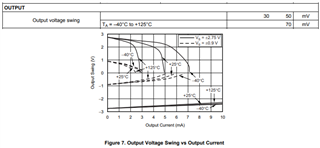Other Parts Discussed in Thread: LM7705, OPA2333
Here is the section from the datasheet p.11. Does the negative voltage need to be same of V+? In other words, can I put -2.5V while V+=3.3V?
Thanks.
This thread has been locked.
If you have a related question, please click the "Ask a related question" button in the top right corner. The newly created question will be automatically linked to this question.
Hi Wenwei,
I think the current is what counts here. 5V / 20k = 250µA. In your case I would try a resistance between 10k and 20k.
Keep in mind, that this sort of output biasing with a negative auxiliary voltage only works for very certain OPAmps, like the OPAx333 and OPAx380, for instance.
Another approach to allow the output voltage of OPAmp to go all the way down to 0V is the use of LM7705.
Kai
Hi Wenwei,
If OPA233P's output has to be swing at the ground, you may use the method presented in section 7.3.4. Or use the method that Kai's suggesting, which it may be easier to deal with. Enclosing an application note on LM7705, capacitive voltage inverter or charge pump, see the link below.

If you have additional questions, please let us know.
Best,
Raymond
Wenwei,
Like ANY single supply CMOS op amp, the OPA2333 swing to a negative rail is limited by the Ron of the lower N-channel output transistor and the current flowing through it. As the output is pushed towards negative rail, the transistor is trioded and thus becomes Ron resistor. If there is no output load, the only current flowing through the transistor is the quiescent current of the output stage, IQo, which limits the output swing (in case of a single supply application) to Vout=IQo*Ron above ground. Thus, as Kai suggested, in order for the output to swing all the way to ground, all of the IQo current needs to be diverted through the external pulldown resistor, Rp. Therefore, you may use any negative voltage for as long as the resulting current through Rp is IQo= 5V/20k =~250uA. All in all, -2.5V and Rp=10k (IQo=2.5V/10k=250uA) should work just fine as well as -1V/4k or -10V/40k, etc.
Thanks all for the help. The answer is precise that it needs to inject 250uA current.
Just to be clear - injecting current implies pushing the current into a pin. However, in order for the OPA2333 output to swing to its negative rail, ~250uA current needs to be pulled (sunk) from the output pin through pull-down resistor, Rp.